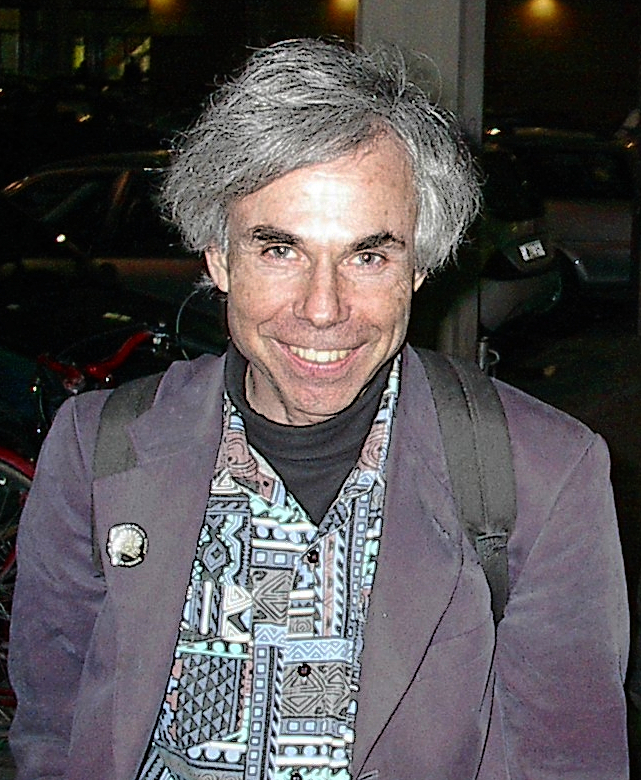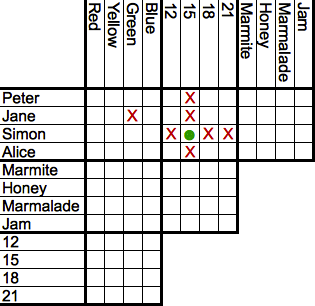|
MU Puzzle
The MU puzzle is a puzzle stated by Douglas Hofstadter and found in ''Gödel, Escher, Bach'' involving a simple formal system called "MIU". Hofstadter's motivation is to contrast reasoning within a formal system (i.e., deriving theorems) against reasoning about the formal system itself. MIU is an example of a Post canonical system and can be reformulated as a string rewriting system. The puzzle Suppose there are the symbols , , and which can be combined to produce strings of symbols. The MU puzzle asks one to start with the "axiomatic" string and transform it into the string using in each step one of the following transformation rules: : Solution The puzzle cannot be solved: it is impossible to change the string into by repeatedly applying the given rules. In other words, MU is not a theorem of the MIU formal system. To prove this, one must step "outside" the formal system itself. In order to prove assertions like this, it is often beneficial to look for an invariant; that ... [...More Info...] [...Related Items...] OR: [Wikipedia] [Google] [Baidu] |
Douglas Hofstadter
Douglas Richard Hofstadter (born 15 February 1945) is an American cognitive and computer scientist whose research includes concepts such as the sense of self in relation to the external world, consciousness, analogy-making, Strange loop, strange loops, artificial intelligence, and discovery in mathematics and physics. His 1979 book ''Gödel, Escher, Bach, Gödel, Escher, Bach: An Eternal Golden Braid'' won the Pulitzer Prize for general nonfiction,"General Nonfiction" . ''Past winners and finalists by category''. The Pulitzer Prizes. Retrieved 17 March 2012. and a National Book Award (at that time called The American Book Award) for Science."National Book Awards – 1980" [...More Info...] [...Related Items...] OR: [Wikipedia] [Google] [Baidu] |
Axiom
An axiom, postulate, or assumption is a statement that is taken to be true, to serve as a premise or starting point for further reasoning and arguments. The word comes from the Ancient Greek word (), meaning 'that which is thought worthy or fit' or 'that which commends itself as evident'. The precise definition varies across fields of study. In classic philosophy, an axiom is a statement that is so evident or well-established, that it is accepted without controversy or question. In modern logic, an axiom is a premise or starting point for reasoning. In mathematics, an ''axiom'' may be a " logical axiom" or a " non-logical axiom". Logical axioms are taken to be true within the system of logic they define and are often shown in symbolic form (e.g., (''A'' and ''B'') implies ''A''), while non-logical axioms are substantive assertions about the elements of the domain of a specific mathematical theory, for example ''a'' + 0 = ''a'' in integer arithmetic. N ... [...More Info...] [...Related Items...] OR: [Wikipedia] [Google] [Baidu] |
Independence Results
Independence is a condition of a nation, country, or state, in which residents and population, or some portion thereof, exercise self-government, and usually sovereignty, over its territory. The opposite of independence is the status of a dependent territory or colony. The commemoration of the independence day of a country or nation celebrates when a country is free from all forms of colonialism; free to build a country or nation without any interference from other nations. Definition Whether the attainment of independence is different from revolution has long been contested, and has often been debated over the question of violence as legitimate means to achieving sovereignty. In general, revolutions aim only to redistribute power with or without an element of emancipation, such as in democratization ''within'' a state, which as such may remain unaltered. For example, the Mexican Revolution (1910) chiefly refers to a multi-factional conflict that eventually led to a new ... [...More Info...] [...Related Items...] OR: [Wikipedia] [Google] [Baidu] |
Unsolvable Puzzles
"Unsolvable" is the twenty-first episode of the first season of the American television police sitcom series ''Brooklyn Nine-Nine''. Written by co-executive producer Prentice Penny and directed by Ken Whittingham, it aired on Fox in the United States on March 18, 2014. In this episode, Jake decides to take on an 8-year-old case that is deemed "unsolvable" and seeks Terry's help in solving it; Amy, planning a romantic vacation with her boyfriend Teddy, tries to obscure her true intentions from Holt; and Boyle, downcast after the end of his relationship, is told of a great secret. The episode was seen by an estimated 2.50 million household viewers and gained a 1.1/3 ratings share among adults aged 18–49, according to Nielsen Media Research. The episode received mostly positive reviews from critics, who praised Andy Samberg's performance. Plot In the cold open, the squad notices Holt's injured his wrist and speculate what could have led to it. Holt breaks them up and secretl ... [...More Info...] [...Related Items...] OR: [Wikipedia] [Google] [Baidu] |
Logic Puzzles
A logic puzzle is a puzzle deriving from the mathematical field of deduction. History The logic puzzle was first produced by Charles Lutwidge Dodgson, who is better known under his pen name Lewis Carroll, the author of ''Alice's Adventures in Wonderland''. In his book '' The Game of Logic'' he introduced a game to solve problems such as confirming the conclusion "Some greyhounds are not fat" from the statements "No fat creatures run well" and "Some greyhounds run well". Puzzles like this, where we are given a list of premises and asked what can be deduced from them, are known as syllogisms. Dodgson goes on to construct much more complex puzzles consisting of up to 8 premises. In the second half of the 20th century mathematician Raymond M. Smullyan continued and expanded the branch of logic puzzles with books such as '' The Lady or the Tiger?'', '' To Mock a Mockingbird'' and ''Alice in Puzzle-Land''. He popularized the " knights and knaves" puzzles, which involve knights, who ... [...More Info...] [...Related Items...] OR: [Wikipedia] [Google] [Baidu] |
Unrestricted Grammar
In automata theory, the class of unrestricted grammars (also called semi-Thue, type-0 or phrase structure grammars) is the most general class of grammars in the Chomsky hierarchy. No restrictions are made on the productions of an unrestricted grammar, other than each of their left-hand sides being non-empty. This grammar class can generate arbitrary recursively enumerable languages. Formal definition An unrestricted grammar is a formal grammar G = (N, T, P, S), where * N is a finite set of nonterminal symbols, * T is a finite set of terminal symbols with N and T disjoint,Actually, T\cap N=\emptyset is not strictly necessary since unrestricted grammars make no real distinction between the two. The designation exists purely so that one knows when to stop generating sentential forms of the grammar; more precisely, the language L(G) recognized by G is restricted to strings of terminal symbols. * P is a finite set of production rules of the form \alpha \to \beta , where \alpha an ... [...More Info...] [...Related Items...] OR: [Wikipedia] [Google] [Baidu] |
Recursive Definition
In mathematics and computer science, a recursive definition, or inductive definition, is used to define the elements in a set in terms of other elements in the set ( Aczel 1977:740ff). Some examples of recursively definable objects include factorials, natural numbers, Fibonacci numbers, and the Cantor ternary set. A recursive definition of a function defines values of the function for some inputs in terms of the values of the same function for other (usually smaller) inputs. For example, the factorial function is defined by the rules :\begin & 0! = 1. \\ & (n+1)! = (n+1) \cdot n!. \end This definition is valid for each natural number , because the recursion eventually reaches the base case of 0. The definition may also be thought of as giving a procedure for computing the value of the function , starting from and proceeding onwards with etc. The recursion theorem states that such a definition indeed defines a function that is unique. The proof uses mathematic ... [...More Info...] [...Related Items...] OR: [Wikipedia] [Google] [Baidu] |
Susanna S
Susanna or Suzanna may refer to: People * Susanna (Book of Daniel), a portion of the Book of Daniel and its protagonist * Susanna (disciple), a disciple of Jesus * Susanna (given name), or Suzanna, a feminine given name (including a list of people with the name) Film and television * ''Suzanna'' (film), a 1923 American silent film * ''Susanna'' (1967 film), a Hong Kong film directed by Ho Meng Hua * ''Susanna'' (2000 film), an Indian Malayalam-language film directed by T. V. Chandran Music * ''Susanna'' (Stradella), a 1681 oratorio by Alessandro Stradella * ''Susanna'' (Handel), a 1749 oratorio by George Frideric Handel * "Susanna" (song), English version of "Suzanne", by VOF de Kunst (The Art Company), 1984 Places * Susanna, Missouri, US See also * Susana (other) * Susanne (other) * Suzanne (other) Suzanne may refer to: People * Suzanne (given name), a feminine given name (including a list of people with the name) * S. U. Zanne, pen name of ... [...More Info...] [...Related Items...] OR: [Wikipedia] [Google] [Baidu] |
Mathematical Proof
A mathematical proof is a deductive reasoning, deductive Argument-deduction-proof distinctions, argument for a Proposition, mathematical statement, showing that the stated assumptions logically guarantee the conclusion. The argument may use other previously established statements, such as theorems; but every proof can, in principle, be constructed using only certain basic or original assumptions known as axioms, along with the accepted rules of inference. Proofs are examples of exhaustive deductive reasoning that establish logical certainty, to be distinguished from empirical evidence, empirical arguments or non-exhaustive inductive reasoning that establish "reasonable expectation". Presenting many cases in which the statement holds is not enough for a proof, which must demonstrate that the statement is true in ''all'' possible cases. A proposition that has not been proved but is believed to be true is known as a conjecture, or a hypothesis if frequently used as an assumption for ... [...More Info...] [...Related Items...] OR: [Wikipedia] [Google] [Baidu] |
Rules Of Inference
Rules of inference are ways of deriving conclusions from premises. They are integral parts of formal logic, serving as norms of the logical structure of valid arguments. If an argument with true premises follows a rule of inference then the conclusion cannot be false. ''Modus ponens'', an influential rule of inference, connects two premises of the form "if P then Q" and "P" to the conclusion "Q", as in the argument "If it rains, then the ground is wet. It rains. Therefore, the ground is wet." There are many other rules of inference for different patterns of valid arguments, such as '' modus tollens'', disjunctive syllogism, constructive dilemma, and existential generalization. Rules of inference include rules of implication, which operate only in one direction from premises to conclusions, and rules of replacement, which state that two expressions are equivalent and can be freely swapped. Rules of inference contrast with formal fallaciesinvalid argument forms involving lo ... [...More Info...] [...Related Items...] OR: [Wikipedia] [Google] [Baidu] |
Formal System
A formal system is an abstract structure and formalization of an axiomatic system used for deducing, using rules of inference, theorems from axioms. In 1921, David Hilbert proposed to use formal systems as the foundation of knowledge in mathematics. The term ''formalism'' is sometimes a rough synonym for ''formal system'', but it also refers to a given style of notation, for example, Paul Dirac's bra–ket notation. Concepts A formal system has the following: * Formal language, which is a set of well-formed formulas, which are strings of symbols from an alphabet, formed by a formal grammar (consisting of production rules or formation rules). * Deductive system, deductive apparatus, or proof system, which has rules of inference that take axioms and infers theorems, both of which are part of the formal language. A formal system is said to be recursive (i.e. effective) or recursively enumerable if the set of axioms and the set of inference rules are decidable ... [...More Info...] [...Related Items...] OR: [Wikipedia] [Google] [Baidu] |



